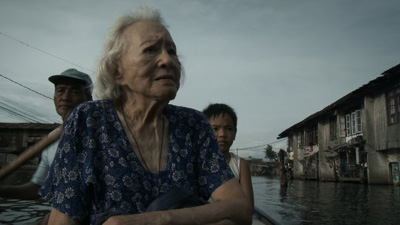 Anita Linda as Lola Sepa.
Anita Linda as Lola Sepa.Just when I thought that Brillante Mendoza will not get out of his trend of sexual and disturbingly putrid depictions of the modern downsides of Philippine society, here he comes bringing "Lola", a painful, yet at times comic, observation of two striving grandmothers on opposite sides of a situation (one whose grandson is the victim and the other, the suspect) trying to cope up with the tragic trails, including financial shortcomings, brought forth by an uneasy crime. Anita Linda and Rustica Carpio, both past their physical primes, may have just given their more-than-impressive swan songs. Director Mendoza, who is not that much known on squeezing out pure performances from his actors/actresses (as his characters usually just blend in into the realistic palette of the surroundings), handled may be the two most astounding ones from aged performers.
In some ways, it's almost a miraculous feat on his part (and cinematographer Odyssey Flores) in terms of enhancing Anita Linda and Rustica Carpio's natural and honest evocation of suppressed sufferings and prolonged sacrifices as impoverished grandparents through a panoramic view of the present social state of those inflicted with destitution. But the real highlight is of course from the two brave, nagging, and at times, swindling heroines who will do just about anything not just to resolve their numerous woes, mostly involving money, but also to unconsciously prove their 'worth'. Throughout the film, as the camera follows them both, we see them express stern authority to younger people, ask for directions and assistance like one, and show extreme determination like middle-aged fellows.
They embody the three stages of life based on the entirety of their characteristics. Their bodies show the tweaks of aging, but when, as they say, push comes to shove, their minds does not.
But in one specific sequence that is arguably the most resonant in the film, our protagonists engage in a very subtle, open and realistic conversation about the simple realities of old age. Many times, I have overheard old people talking. No, they do not talk about transcendent and elegiac things such as existence and life affirmations. Instead, they talk about the most trivial of things such as aching bodies, rheumatism and efficascent oils.
Brillante Mendoza captured the sequence with lightness and sheer minimalism. Amid the laborious small journeys here and there, this scene is their break. They do not reflect upon paradoxical things about their hardships but merely talk with a sense of common likeness. Although being the opposites in a tragedy, they share the beauty of human 'connection'.
At times visually and thematically similar with Nagisa Oshima (based especially on his explicitly unrelenting "Serbis" and "Kinatay"), Brillante Mendoza departed from the comparison to simply tell a poignant story. And what makes "Lola" even more fascinating albeit at times being emotionally painful is its underlying tenderness that treats these aged heroines of life not as urban sufferers but as rare triumphants.
Mendoza has already channeled the polarizing alternatives of cinema, but with "Lola", he may have glanced on some of De Sica and Ozu's brushstrokes and created an absorbing and empathetic film about human struggles and tribulations. Anita Linda and Rustica Carpio's performances made it all the more affecting.
In some ways, it's almost a miraculous feat on his part (and cinematographer Odyssey Flores) in terms of enhancing Anita Linda and Rustica Carpio's natural and honest evocation of suppressed sufferings and prolonged sacrifices as impoverished grandparents through a panoramic view of the present social state of those inflicted with destitution. But the real highlight is of course from the two brave, nagging, and at times, swindling heroines who will do just about anything not just to resolve their numerous woes, mostly involving money, but also to unconsciously prove their 'worth'. Throughout the film, as the camera follows them both, we see them express stern authority to younger people, ask for directions and assistance like one, and show extreme determination like middle-aged fellows.
They embody the three stages of life based on the entirety of their characteristics. Their bodies show the tweaks of aging, but when, as they say, push comes to shove, their minds does not.
But in one specific sequence that is arguably the most resonant in the film, our protagonists engage in a very subtle, open and realistic conversation about the simple realities of old age. Many times, I have overheard old people talking. No, they do not talk about transcendent and elegiac things such as existence and life affirmations. Instead, they talk about the most trivial of things such as aching bodies, rheumatism and efficascent oils.
Brillante Mendoza captured the sequence with lightness and sheer minimalism. Amid the laborious small journeys here and there, this scene is their break. They do not reflect upon paradoxical things about their hardships but merely talk with a sense of common likeness. Although being the opposites in a tragedy, they share the beauty of human 'connection'.
At times visually and thematically similar with Nagisa Oshima (based especially on his explicitly unrelenting "Serbis" and "Kinatay"), Brillante Mendoza departed from the comparison to simply tell a poignant story. And what makes "Lola" even more fascinating albeit at times being emotionally painful is its underlying tenderness that treats these aged heroines of life not as urban sufferers but as rare triumphants.
Mendoza has already channeled the polarizing alternatives of cinema, but with "Lola", he may have glanced on some of De Sica and Ozu's brushstrokes and created an absorbing and empathetic film about human struggles and tribulations. Anita Linda and Rustica Carpio's performances made it all the more affecting.



No comments:
Post a Comment